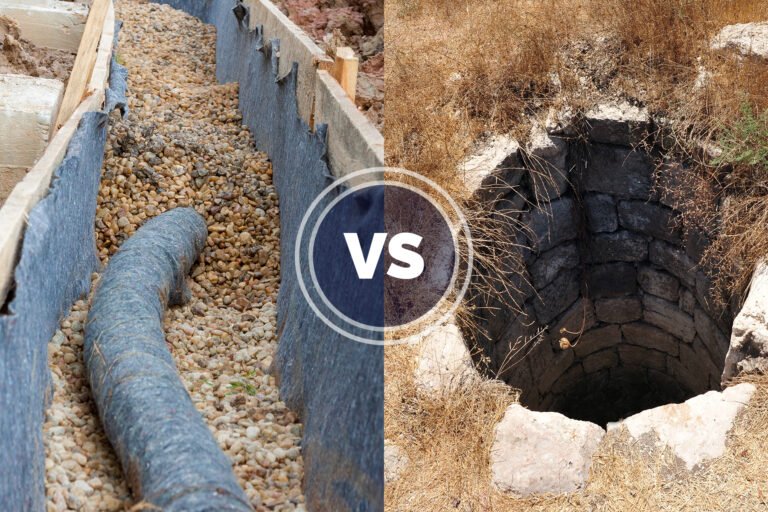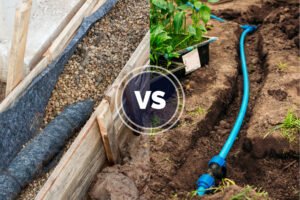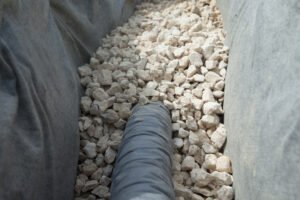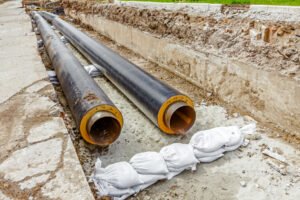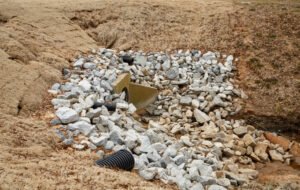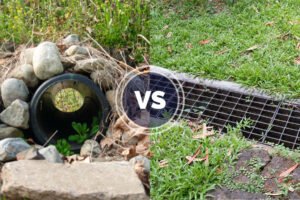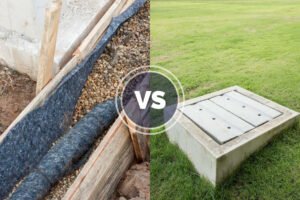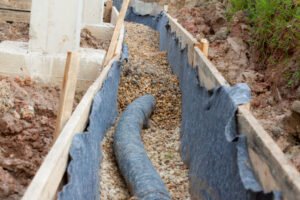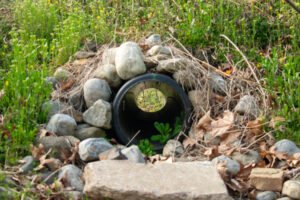The heavy rain often damages your yard beyond repair. And as smelly as it is, surface water might cost hefty charges on fence and foundation repair. So, you need a permanent drainage solution to direct the water flow and halt all your yard drainage problems.
And french drains and dry wells will manage the excess runoff and disperse it to deeper soil and gravel. However, these have different depths, drainage capacities, and speeds. So they need specific yard designs and weather conditions to work correctly.
Hence, we analyzed all these conditions, compared the locations, mechanisms, and characteristics of french drains and dry wells, and picked some tips for better understanding. So, let’s examine all these differences and choose the best yard drainage system for you.
What Is a French Drain?
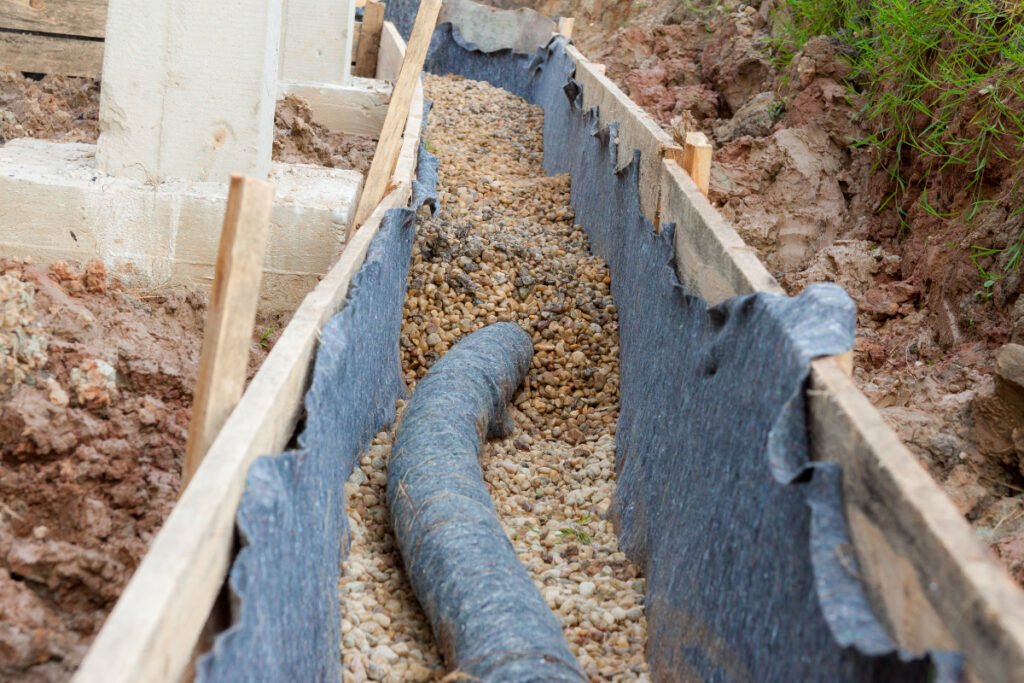
A french drain is an exterior trench drain with a perforated pipe that collects the excess water from your gardens and lawns and channels it downhill using gravity. Thus, it protects the foundations and basements from further water damage and relieves the hydrostatic pressure from the retaining wall.
How Does a French Drain Work: A french drain usually sits on a downward slope with a thick gravel layer that absorbs the runoff water and directs it to the drainage pipe. The pipe pushes it towards a drainage ditch but filters all the debris and sediment to maintain the proper flow.
A french drain is a shallow surface drain that prevents flooding by discharging the water to low-lying areas. Thus, it isn’t as deep as a dry well and holds different landscape elements and grasses. Plus, it isn’t vertically inclined like a dry well but has a downward slope that pushes water to the ditch.
Additionally, a french drain system might have a drain fabric, crushed stone surrounds, or a rain barrel that filters the water and prevents contamination. And you can install it near your cellar or basement waterproofing, unlike a dry well that needs a vast site area.
However, a french drain has a slower drainage speed and cannot be used in high-rainfall areas. Plus, french drain installation is a bit tedious and needs professional help, unlike a drywell that can be dug easily.
| Average Cost | $ 10 – 90 per linear foot |
| Average Lifespan | 8 – 10 years |
| Pipe Materials | Corrugated or perforated Iron or PVC pipe |
Clean the french drains annually with regular pressure washers or high-pressure water jet cleaners to prevent sedimentation and clogging.
What Is a Dry Well?
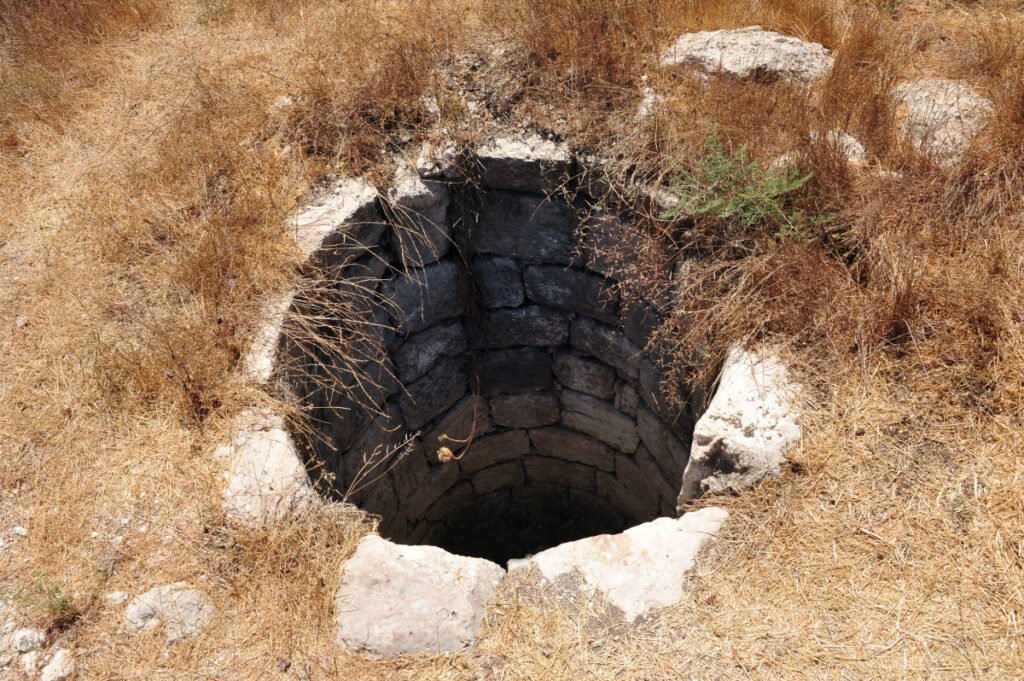
Dry wells are deep, bored holes that catch the excess runoff from surface drains and discharge the water to the ground below. Thus, they prevent flooding and protect your landscape from further water damage.
How Does It Work: Dry wells are excellent french drain alternatives with gravel and fabric-lined tube that retain the vertical trench shape, filter water, and channel it to the surrounding soil. They may have some perforated casings that remove oil and other contaminants, thus preventing clogging effectively.
A dry well pushes the surface water to the ground and prevents backflow to the house. Thus, it is an excellent termination point for any french or trench drain and catch basin and can be used in high-rainfall areas to prevent overflowing.
Moreover, you can add concrete or polyethylene tanks to boost its water capacity, unlike an interior french drain that doesn’t expand on installation. Or, you can line it with brick walls for more security.
However, dry wells are limited to small, less than one-acre sites, unlike a french drain that covers the whole area. And contrary to a shallow french drain that works in clay soils, dry wells need coarse loamy or sandy soils for drainage. But, they are easier to dig and clean.
| Average Cost | $ 3000 – 4000 |
| Average Lifespan | 30 – 35 years |
| Siding Materials | Cement, Brick, Stone, Stone composite, Metal |
Dry wells might cause a drainage problem in clay soils. So, always call a professional and conduct a percolation test to check its drainage speed.
Difference Between a French Drain and a Dry Well
French drains and dry wells are used to reduce flooding and surface water percolation, but both have different depths, costs, installation, and problems that affect your yard drainage. So, let’s compare them and pick the best one to solve your drainage issue.
1. Location
French drains are installed around the gardens, lawns, driveways, and patios to drain away the surface water. Still, they can be mounted on the site’s highest and lowest points or near the foundations to get rid of the standing water.
Inversely, dry wells are always installed in low-lying areas or garden corners away from home.
2. Function
French drain systems break the flow, direct water to low-lying drainage ditches and pools, and prevent flooding and marshiness on the overall site.
On the other hand, a dry well accepts water from different surface and roof runoff drainage systems, holds it, and percolates it into the surrounding soil and gravel.
3. Cost
French drain cost varies between $10-50 per linear foot for perimeter drains and $40-90 for interior french drains, whereas dry wells cost about $3000 – 4000 for the entire excavation and lining.
4. Ease of Repair
While french drains are relatively easy to repair and only need regular snaking and declogging of the french drain pipe for optimal function, dry wells are a bit tricky and must be re-excavated and filled when clogged.
5. Structure
French drains are simple and consist only of a small perforated pipe with landscape fabric, gravel, and soil in the trench.
In contrast, dry wells are long stone or concrete tubes with thicker walls that hold and store water till it drains into the surrounding soil.
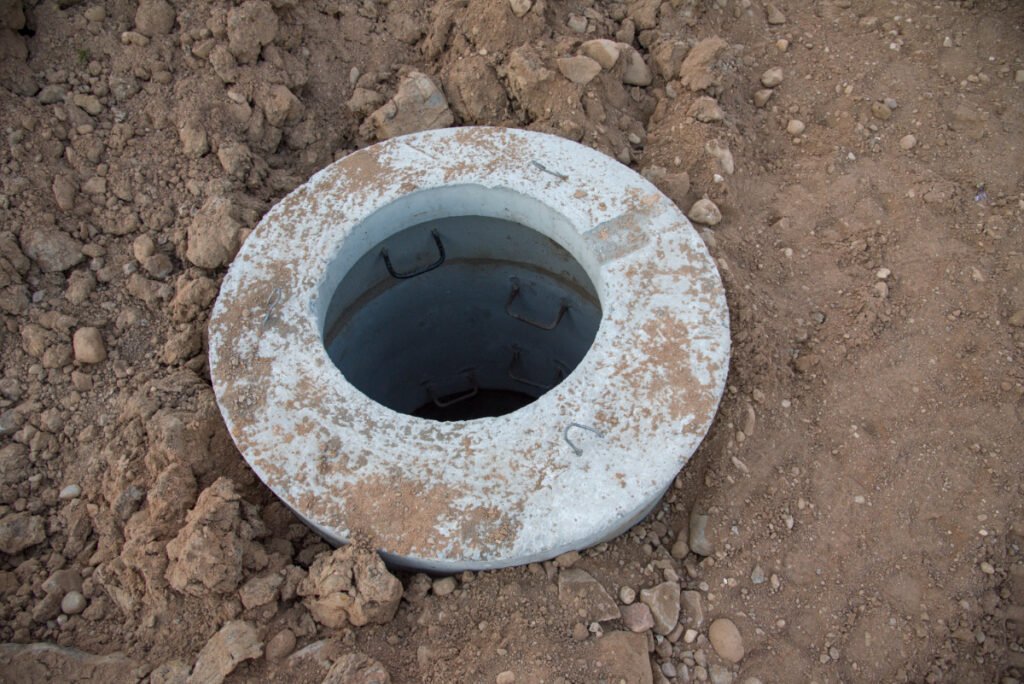
Here are some more points to compare a french drain and dry well:
| Parameter | French Drain | Dry Well |
| Depth | 8 – 12 inches | 30 – 70 feet |
| Water Source | Rain or Snow | Surface drain, Gutter or Roof Runoff drainage systems |
| Type of Soil | Mixed, Grainy or Clayey | Coarse, Grainy or Loamy |
| Distance from the House | 3 – 5 feet | 12 – 14 feet |
| Visibility | Well-hidden under lawns and turf | Easily visible in the garden corners and low-lying areas |
| Speed of Drainage | Moderate to High, depending on the presence of a sump pump | Very high and Efficient |
| Terrain | Flat or Sloping | Flat land |
| Installation | Tedious and needs a professional french drain man | Easy, can be manually dug |
| Gravel | Non-porous river rock | Any river rock, hard stone, soft stone or concrete chips |
What Type of Drain Is the Best for Heavy Rain?
Dry wells are more efficient in high rainfall areas and can hold up to 5 gallons of water per foot, depending on the type of gravel used. In contrast, french drains do not hold any water and can overflow with heavy rain and direct the water back to the house.
Use a non-porous french drain rock to drain the excess rainwater and prevent its percolation in the yard.
What Type of Drain Is the Best for Water Flow?
Dry wells have a higher water capacity of 500-600 gallons per minute, whereas french drains are relatively slow and can move about 200 gallons of water per minute. But, you can use a sump pump and increase the flow to 240 gallons per minute in flooded areas.
Which Type of Drain Is the Best for Collecting Water Runoff?
A french drain is the best to catch all the surface runoff and drain it away from the house. In contrast, a dry well will just collect the excess discharge from the drains and won’t prevent flooding or sogging in the backyard.
Which Drainage System Is Easy to Install?
Dry wells are easier to install and have a simple wall and gravel lining over a deep trench, whereas french drains are tedious to install and need a precise route, slope, and drain pipe for optimal function.
Hence, a dry well can be customized, but a french drain needs professional installation.
Can You Use a French Drain and Dry Well Together?
Yes, you can terminate a french drain into a dry well if there are no nearby ponds or rivers available. However, you’ll need to use a larger, 3-5 foot dry well and filter out all the heavy clay content and grassroots to avoid clogging.
Always direct the french drain pipe to the center of the dry well and cover it with a grate for better filtration.
Tips for Choosing the Best Drain for Your Yard
- Install french drains on the naturally sloping portions of the site, but limit dry wells to site corners and flat terrain.
- Pick french drains to catch the runoff from a larger yard, but use dry wells to prevent standing water in a smaller area.
- Use french drains to prevent water damage near basements and foundations, but limit dry wells to above-ground applications.
- French drains are vulnerable to mosquito breeding. So, choose dry wells for marshy areas with pest problems.
- Select dry wells for coarse-soil sites and french drains for clayey or loamy soils.
- Pick dry wells for larger yards and sites, and use french drains for compact sites and bungalows.
Should I Use a French Drain or Dry Well?
Use a french drain to prevent water damage and percolation along your foundations, basements, and retaining walls, but use a dry well as a discharge point to prevent overflowing and waterlogging.
Does a Dry Well Work in Clay Soil?
No, a dry well doesn’t work in clay soil and might deform or cause waterlogging if wrongly installed. Plus, clay soils don’t hold the weight of dry well walls and might buckle under water pressure.
Why Do Dry Wells Fail?
Dry wells might fail due to a faulty installation, thinner walls, or clogging due to excessive soil, gravel, rocks, and pebbles. Or, heavier water discharge pipes might pressurize the dry well walls and cause a failure.
Can a Drywell Cause a Sink Hole?
Yes, dry wells can cause sinkholes as they continuously change the groundwater levels and drain all the excess water into the surrounding soil. Hence, use thicker walls and add 1-inch river rock for better support.
French drains and dry wells are efficient systems to catch the runoff and direct it to the ground. But, french drains absorb the surface water and prevent flooding, whereas dry wells hold the water and prevent overflowing drains.
Further, you can combine both these systems for efficient water drainage in high rainfall areas, or you can use simple trench drains to discharge all the water from your landscapes. But, which is better – a french drain or trench drain? Join us to know more!

